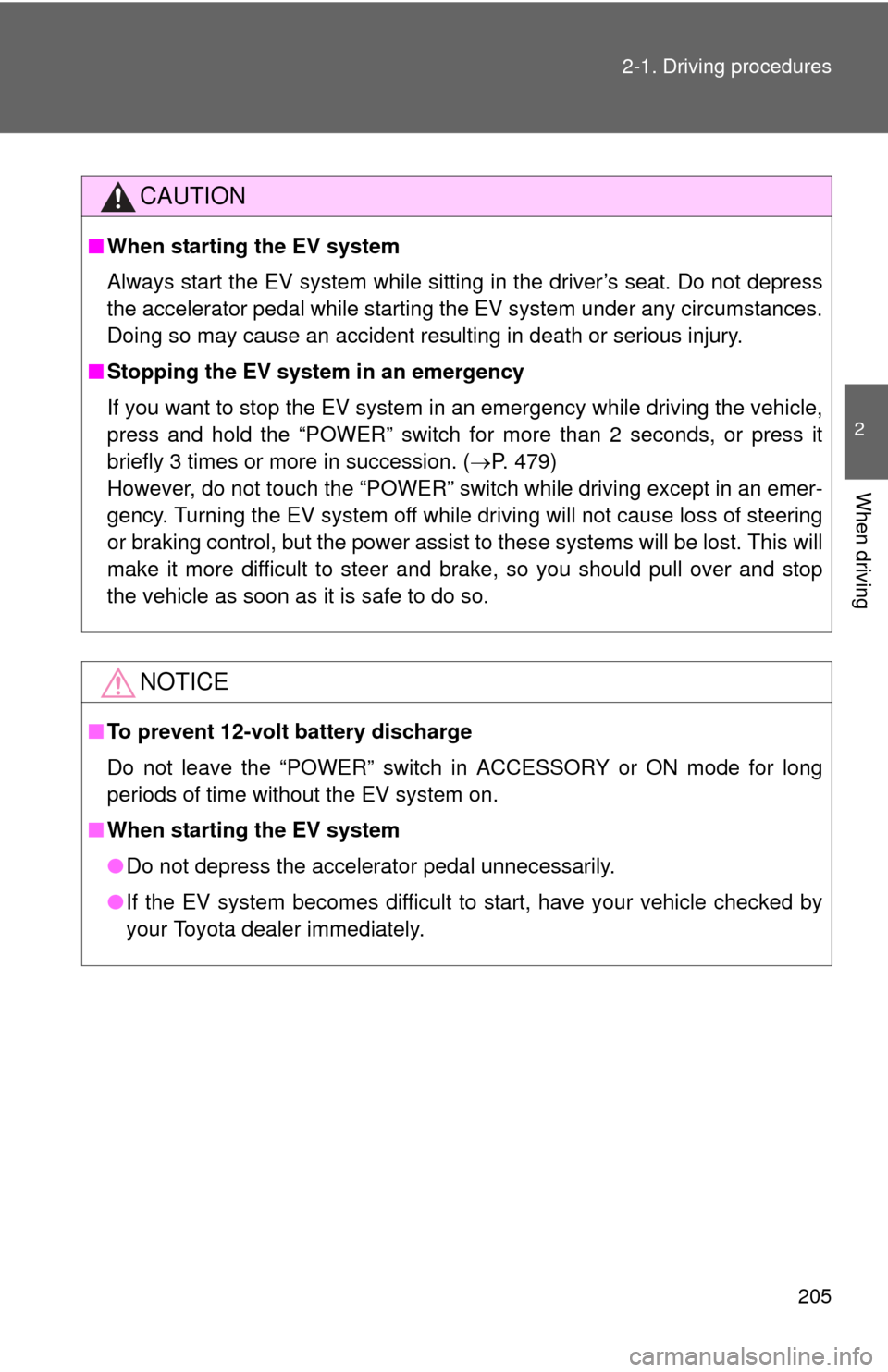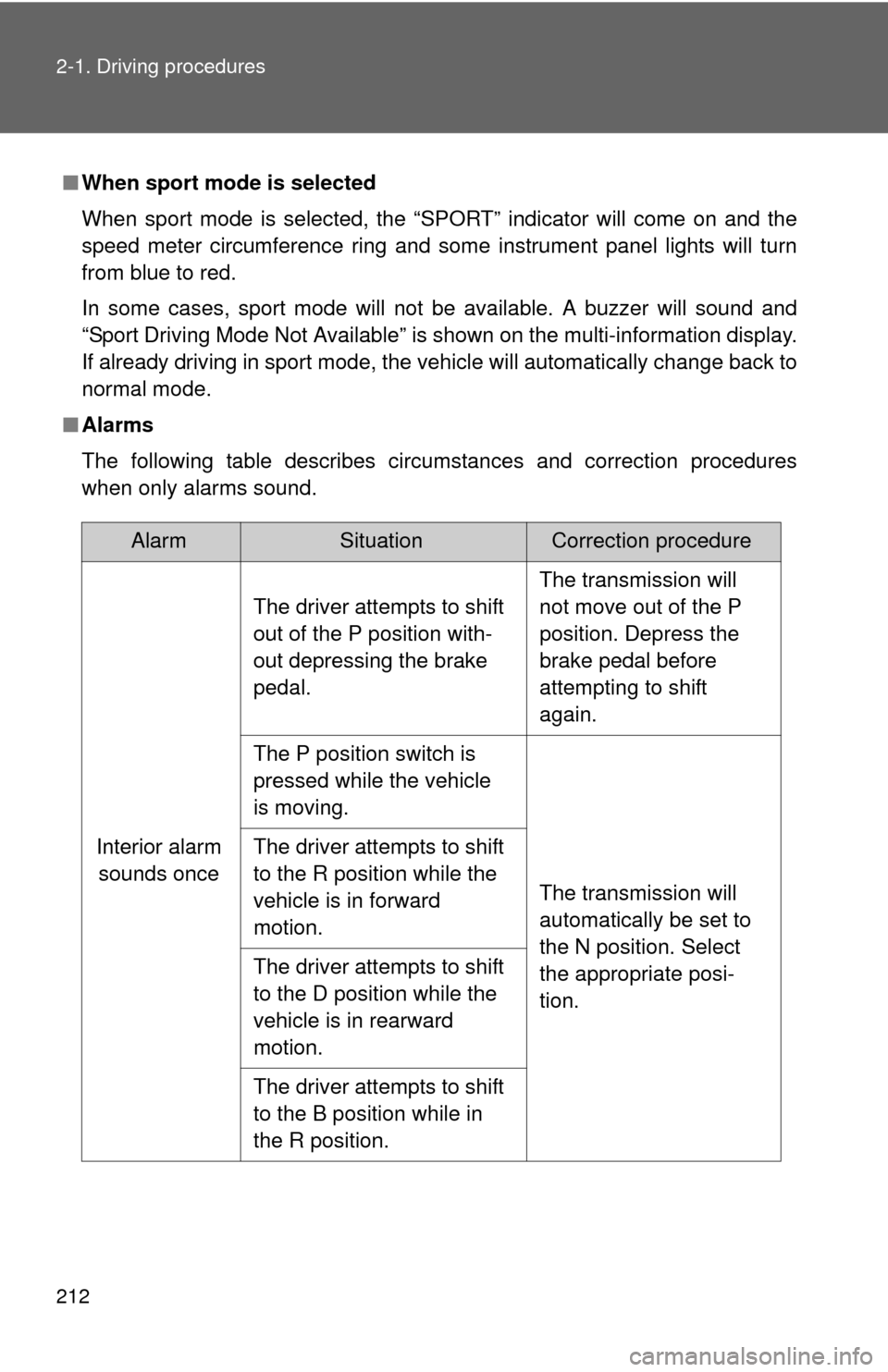Page 203 of 520

203
2-1. Driving procedures
2
When driving
■
Auto power off function
If the vehicle is left in ACCESSORY mode for more than an hour with the
shift position in P, the “POWER” switch will automatically turn off.
■ Sounds and vibrations specific to a electric vehicle
P. 3 0
■ Electronic key battery depletion
P. 106
■ Auto P position function
●If the “POWER” switch is pressed while the EV system is operating and
the vehicle is at a complete stop, the “POWER” switch will be turned to
OFF, then the shift position will be automatically switched to P.
When turning the “POWER” switch to off while the shift position is not set
to P, operate the “POWER” switch while pushing down fully on the brake
pedal. Then, release the brake pedal after confirming that the shift posi-
tion indicator on the instrument cluster shows P.
● If the auto P position function is malfunctioning, it may not be possible to
turn the “POWER” switch to off. In this event, the “POWER” switch can
be turned to off after applying the parking brake.
Have the vehicle inspected by your Toyota dealer immediately.
■ When the ambient temperature is low, such as during winter driving
conditions
Driving power may be limited due to traction battery temperature being low.
Follow the instructions on the meter display. If the vehicle has been parked
for a long time in low ambient temperatures, it may be necessary to plug in
the vehicle to warm-up and charge the traction battery before driving.
■ When the P position cont rol system malfunctions
The “POWER” switch will not be able to be turned off. In such a case, the
switch can be turned off after applying the parking brake.
Have the vehicle inspected by your Toyota dealer immediately.
■ Conditions affecting operation
P. 104
■ Note for the entry function
P. 105
Page 204 of 520
204 2-1. Driving procedures
■If the EV system does not start
●The immobilizer system may not have been deactivated. ( P. 149)
Contact your Toyota dealer.
● The charging cable may be connected to the vehicle. ( P. 82)
■ When the steering lock cannot be released
■ When the “POWER” switch in dicator flashes in amber
The system may be malfunctioning. Have the vehicle inspected by your
Toyota dealer immediately.
■ If the “READY” indicator does not come on
If the “READY” indicator does not come on when you press the “POWER”
switch with the shift position in P and the brake pedal pressed, contact your
Toyota dealer immediately.
■ If the EV system is malfunctioning
P. 428
■ When the electronic key battery is discharged
P. 383
The green indicator light on the “POWER”
switch will flash and a message will be
shown on the multi-information display.
Press the “POWER” switch again while
turning the steering wheel left and right.
Page 205 of 520

205
2-1. Driving procedures
2
When driving
CAUTION
■
When starting the EV system
Always start the EV system while sitting in the driver’s seat. Do not depress
the accelerator pedal while starting the EV system under any circumstances.
Doing so may cause an accident resulting in death or serious injury.
■ Stopping the EV system in an emergency
If you want to stop the EV system in an emergency while driving the vehi\
cle,
press and hold the “POWER” switch for more than 2 seconds, or press it
briefly 3 times or more in succession. ( P. 479)
However, do not touch the “POWER” switch while driving except in an emer-
gency. Turning the EV system off while driving will not cause loss of steering
or braking control, but the power assist to these systems will be lost. This will
make it more difficult to steer and brake, so you should pull over and stop
the vehicle as soon as it is safe to do so.
NOTICE
■ To prevent 12-volt battery discharge
Do not leave the “POWER” switch in ACCESSORY or ON mode for long
periods of time without the EV system on.
■ When starting the EV system
●Do not depress the accelerator pedal unnecessarily.
● If the EV system becomes difficult to start, have your vehicle checked by
your Toyota dealer immediately.
Page 206 of 520
206
2-1. Driving procedures
Transmission
Select a shift position appropriate for the driving conditions.
■Shifting the shift lever
Shift lever
Operate the shift lever gently and ensure correct shifting operation.
When shifting to D or R positions, move the shift lever along
the shift gate.
To shift to N position, slide the shift lever to the left and hold
it. The shift position will change to N.
Shifting to B is only possible when shift position D is
selected.
The shift lever always returns to this original position after a
shifting operation.
When shifting from P to N, D or R; from D to R; or from R to D,
ensure that the brake pedal is be ing depressed and the vehicle is
stationary.
Page 209 of 520
209
2-1. Driving procedures
2
When driving
P position switch
■ When shifting the shift position to P
Fully stop the vehicle and set the
parking brake, and then press
the P position switch.
When the shift position is
changed to P, the indicator on the
P position switch illuminates.
Check that the shift position indi-
cator on the instrument cluster
shows P.
■Shifting the shift position from P to other positions
●While depressing the brake pedal firmly, operate the shift lever.
If the shift lever is operated wi thout depressing the brake pedal,
the buzzer will sound and the shifting operation will be disabled.
● When selecting a shift position, make sure that the shift position
has been changed to the desired pos ition by checking the shift
position indicator provided on the instrument cluster.
● The shift position cannot be changed from P to B directly.
Page 210 of 520

210 2-1. Driving procedures
■For the shift positions
●When the “POWER” switch is off, the shift position cannot be changed.
● When the “POWER” switch is in ON mode (the EV system is not operat-
ing), the shift position can only be changed to N. The shift position will be
changed to N even if the shift lever is shifted to D or R and held in that
position.
● When the “READY” indicator is on, the shift position can be changed
from P to D, N or R.
● When the “READY” indicator is flashing, the shift position cannot be
changed from P to another position even if the shift lever is operated.
Wait until the “READY” indicator changes from a flashing to a solid light,
and then operate the shift lever again.
● The shift position can only be changed to B directly from D.
In addition, if the shift position is changed in any of the following situations,
the buzzer will sound and the shifting operation will be disabled or the shift
position will automatically change to N. When this happens, select an appro-
priate shift position.
● Situations where the shifting operation will be disabled:
• When the shift position is changed from P to another position while the
charging cable is connected to the vehicle.
• When the shift position is changed from P to another position without depressing the brake pedal.
• When the shift position is changed from P or N to B.
● Situations where the shift position will automatically change to N:
• When the P position switch is pressed while the vehicle is running.
*1
• When shift position R is selected when the vehicle is moving forward.*2
• When shift position D is selected when the vehicle is moving in
reverse.
*3
• When the shift position is changed from R to B.
*1: Shift position may be changed to P when driving at extremely lowspeeds.
*2: Shift position may be changed to R when driving at low speeds.
*3: Shift position may be changed to D when driving at low speeds.
Page 211 of 520

211
2-1. Driving procedures
2
When driving
■
Reverse warning buzzer
When shifting into R, a buzzer will sound to inform the driver that the shift
position is in R.
■ Automatically P position selection function
When the “POWER” switch is in ON mode while the shift position is in a
position other than P and the vehicle is stopped completely, pressing the
“POWER” switch will cause the automatic P position selection function to
operate together with the “POWER” switch being turned to off.
■ If the shift position cannot be shifted from P
There is a possibility that the 12-volt battery is discharged. Check the 12-volt
battery in this situation. ( P. 470)
■ Using regenerative braking
When shift position D or B is selected, releasing the accelerator pedal will
apply regenerative braking.
The vehicle can be accelerated even when shift position B is selected.
If the brake pedal is depressed very quickly after the accelerator pedal is
released, the amount of regenerated energy displayed on the EV system
indicator ( P. 221) may be less than expected. This is not a malfunction,
and will probably not feel any different than usual. The amount of regener-
ated energy will return to expected when the brake pedal is released and
depressed again.
■ If the system malfunctions
The following situations indicate a problem with the system.
Immediately stop the vehicle in a safe place and contact your Toyota dealer.
●All frames of the shift position indicators in the instrument cluster flash.
● The parking system error message appears on the multi-information dis-
play.
● The instrument cluster does not come on when the “POWER” switch is in
ON mode.
Page 212 of 520

212 2-1. Driving procedures
■When sport mode is selected
When sport mode is selected, the “SPORT” indicator will come on and the
speed meter circumference ring and some instrument panel lights will turn
from blue to red.
In some cases, sport mode will not be available. A buzzer will sound and
“Sport Driving Mode Not Available” is shown on the multi-information display.
If already driving in sport mode, the vehicle will automatically change back to
normal mode.
■ Alarms
The following table describes circumstances and correction procedures
when only alarms sound.
AlarmSituationCorrection procedure
Interior alarm sounds once The driver attempts to shift
out of the P position with-
out depressing the brake
pedal.
The transmission will
not move out of the P
position. Depress the
brake pedal before
attempting to shift
again.
The P position switch is
pressed while the vehicle
is moving.
The transmission will
automatically be set to
the N position. Select
the appropriate posi-
tion.
The driver attempts to shift
to the R position while the
vehicle is in forward
motion.
The driver attempts to shift
to the D position while the
vehicle is in rearward
motion.
The driver attempts to shift
to the B position while in
the R position.